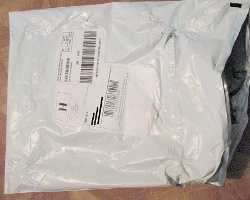 Kayci has emailed:
Kayci has emailed:
First off, I absolutely love your website and all the nifty and creative ideas your community finds.
Now for a confession: I am a bookworm. I typically go through 100+ novels a year without breaking a sweat. In an effort to try and green up my hobbies I’ve stopped going to the used bookstore as often, as it is a twenty mile drive, and when I do go I always buy in bulk. I’ve also switched from Amazon to thriftbooks.com. They’re consistently cheaper, and they reward you for buying used books out of the same location.
My problem? Amazon always uses boxes, even if it was three or four of them per order. My new website sends my books in one large plastic bag (picture enclosed) that is numberless as far as recycling is concerned. The bags in question (I’ve amassed six so far) are 12×16 inches and have some minor holes from the shipping process. The texture of the bag isn’t conducive to making it into plarn, as it stretches out very easily. Any other ideas?
Hi fellow bookworm :)
The first thing you should do is email thriftbooks and explain your problem – they might not take action and change to cardboard (or similar) straightaway but the more people who complain about it, the more likely they are to change at some point — so join that chorus.
If they’re in good condition, and have been opened neatly with scissors, they can be reused for their original purpose – as a slightly smaller mailing sack next time you need to send something out. Unless you send a lot of things though, they may quickly mount up.
When we get those type of bags (and actually there is one on my desk right now that needs reusing!), we tend to use them as bin liners – obviously holey ones aren’t going to be good for small/wet rubbish but they’re fine in most circumstances.
That’s not terrible creative though – any other ideas?
Categories: items, packaging, paper & stationery
Posted by louisa
on 24 June 2011
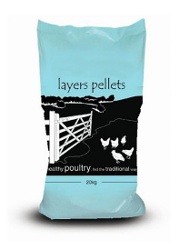 Over on the Suggest an Item page, Emily asked:
Over on the Suggest an Item page, Emily asked:
Would anybody have any ideas for reusing the bags that stock feed comes in? They are some sort of plastic and not recycleable.
Funnily enough, I had this on my to-do list already as I’m starting to be overrun with the things too – and I’ve only got six small chickens, so I can’t imagine how many are generated by people with lots of animals/birds. (Mine are the heavy-duty flat plastic types – we’ve covered the woven plastic type ones before.)
The things I already do with mine:
- refill them with bedding & litter when cleaning out the coop. I bag it sometimes rather than tipping it all into the compost heap so I can give it to friends/family as fertiliser. Such a lovely gift! ;)
- use them to line the wooden planters I make. (I do this with some hesitation for fruit/veg containers as I don’t know what plastic it is so there may be some leaching issues.)
- use them as rubble sacks – they’re not quite as strong as actual rubble sacks but still pretty useful
I also know some people use them to “waterproof” ceilings of hen/duck houses, and I have a plan to build up the floor in our coop, and will cover it with these bags to make it easier to clean. Away from chicken stuff, I’ve seen people using opaque bags as weed barriers around trees.
Any other suggestions for ways to reuse them? Or any advice on recycling?
One thing I would say, as ever, is try to reduce your collection of them – look to see if there are any paper-bagged alternatives. If you’re storing the feed in a dry place, the paper getting damp shouldn’t be an issue. The heavy paper could be composted or recycled. Any other advice?
Categories: garden, items, packaging
Posted by louisa
on 20 June 2011
 I’m possibly a bit late with this now (sorry Su!) but I just spotted this question and wondered if anyone had any advice/info/suggestions for further research.
I’m possibly a bit late with this now (sorry Su!) but I just spotted this question and wondered if anyone had any advice/info/suggestions for further research.
Good friend of Recycle This and The Really Good Life Su asked:
Next week I am at a conference all week. One of the motions for discussion (which is supported) is about replacing union reps and H&S reps existing card cards with plastic credit card type. If this motion actually gets discussed (it probably won’t get prioritised) I intend to speak against the motion.
However, I need as much ‘ammunition’ as possible and wondered if anybody knew anything about the emissions released during manufacture, how long if ever, they take to degrade & anything else that might be relevant. Call this pre-emptive reducing!
I know that most credit cards are made from PVC which is hard to recycle, doesn’t readily breakdown and releases nasty chemicals if burned and during its manufacture – Greenpeace want PVC restricted/banned, as it already is in some European countries. It is possible (just a bit more expensive) to have credits cards made from PET (plastic code 1) — that’s a lot more widely recycled but still obviously uses resources in its manufacturing.
A bit of digging turned up this story from Slate magazine in 2009, which says about PVC cards:
It takes about 4.25 grams of petroleum to manufacture one 5-gram credit card. Multiply that by 1.6 billion — the number of credit, debit, and ATM cards produced in America in 2007 — and we’re looking at roughly 45,000 barrels of oil a year just to make the plastic that feeds our late-night eBay sprees. Granted, that’s a drop in the bucket compared with the 20 million barrels Americans consume daily. But those figures don’t include the billions of gift cards, loyalty cards, and store charge cards we stuff in our wallets each year.
And apparently:
In addition [to the petroleum], a variety of laminates, inks, dyes and other chemicals are used in their production.
Anyone else got anything else Su could use?
Categories: household, reduce this
Posted by louisa
on 17 June 2011
It’s been a while since I’ve featured some of the wonderful reusing, recycling and upcycling links I’ve spotted recently. So, without further ado…:
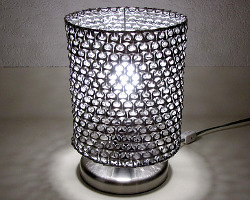
- Drinks can pop top lampshade I love this lampshade made with drinks can pop tops – it’s like modern chainmail :)
- Drinks can bottoms necklace The other end of the cans – a great reuse since so many crafts using the pop tops or the sides of the cans, but I’ve not seen many using the stiffer curved bottoms.
- Fake shell-like pendants from bubble wrap Following on in the “you’d never guess what this necklace used to be” line, this tutorial shows you how to make shell-like decorations for jewellery from bubble wrap.
- Old jeans into placemats I think I’ve seen something like this before but it’s still a great idea – denim placement from old jeans, using the pockets as cutlery/napkin holders – cute!
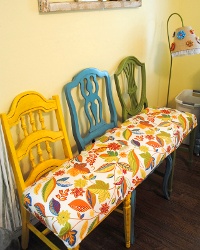
(Bench photo by Kindall)
Categories: art & crafts using recycled stuff, links, recycled jewellery
Posted by louisa
on 16 June 2011
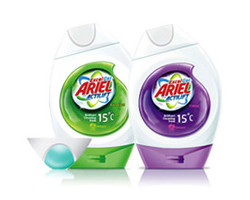 Granny Cain emailed about Ariel Gel Dosing Devices:
Granny Cain emailed about Ariel Gel Dosing Devices:
Enough!! I now have enough dosing devices for each child in a classroom…. but what to do with them? Tried poking a hole through the side, adding twine and making a bird feeder, but it kept flipping over. Needed some technical refinement… too much for my puddle brain. So folks please help me out!
I hadn’t heard about these dosing device but by the looks of it, they’re the new version of ye olde washing powder dosing balls but according to the only tiny picture I can find of them, more of a bowl than a ball, and apparently it “contain[s] an integrated soft plastic sphere”, whatever that means. (Is that right?)
Firstly, it’s obvious but since “reduce” is the most important thing to do, it’s worth repeating: really try not to collect any more. Liquid laundry detergent has a far bigger carbon footprint in packaging and transport costs – the gel is supposed to be a bit better on both accounts (and does promote itself on the idea that it can be used effectively at low (below 40C) temperatures) – but still.
As for the stash that’s already been collected, I’m struggling for ideas – either on how to make them into a bird feeder or anything else – since I’ve not actually seen one in the flesh — so over to you guys! Any reuse suggestions or recycling ideas?
Categories: household, items, packaging
Posted by louisa
on 15 June 2011
 Kayci has emailed:
Kayci has emailed:


 Over on the Suggest an Item page, Emily asked:
Over on the Suggest an Item page, Emily asked: I’m possibly a bit late with this now (sorry Su!) but I just spotted this question and wondered if anyone had any advice/info/suggestions for further research.
I’m possibly a bit late with this now (sorry Su!) but I just spotted this question and wondered if anyone had any advice/info/suggestions for further research.

 Granny Cain emailed about Ariel Gel Dosing Devices:
Granny Cain emailed about Ariel Gel Dosing Devices:














